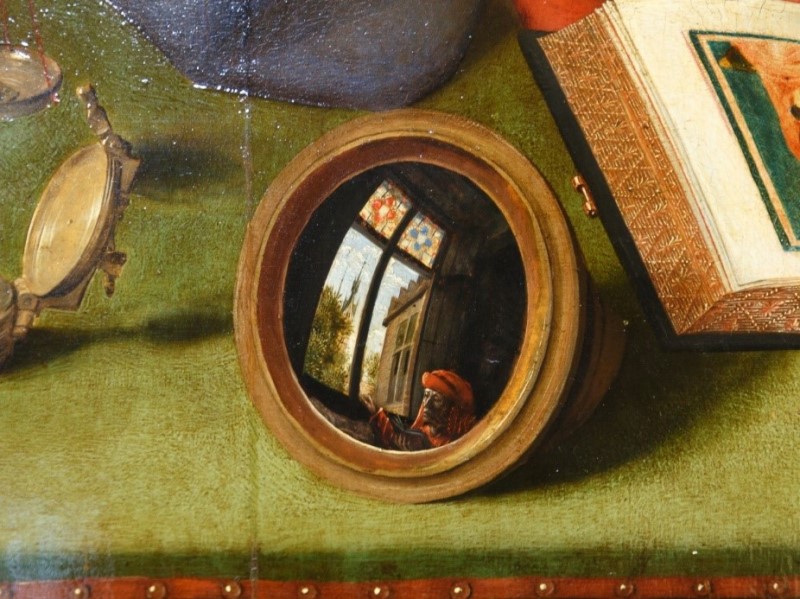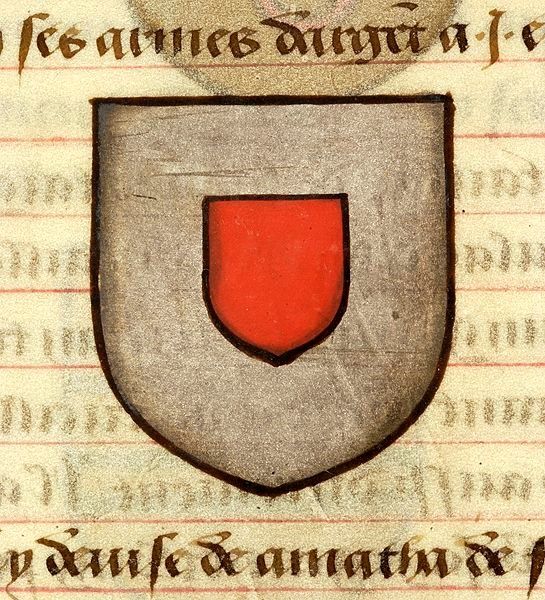 Edit article
Edit articleSeries
The Torah’s Use of Mise en Abyme

Moses reads to the people. “The Testament and Death of Moses,” a fresco attributed to Luca Signorelli and Bartolomeo della Gatta, around 1482, the Sistine Chapel, Rome. Wikimedia
Covenant Collection: A Book within a Book
After the revelation of the Decalogue, YHWH continues speaking to Moses, with messages that he is to bring to the people (Exod 20:19/22), including a handful of cultic laws, followed by a long collection of rules:
שמות כא:א וְאֵלֶּה הַמִּשְׁפָּטִים אֲשֶׁר תָּשִׂים לִפְנֵיהֶם.
Exod 21:1 These are the rules that you shall set before them.[1]
The rules continue through 23:19 and make up what scholars call the Covenant Collection or Code [CC]. After this, YHWH communicates to Moses information about the Israelites’ entry into Canaan (23:20–33).
Moses then communicates the laws of the CC to the people:
שמות כד:ג וַיָּבֹא מֹשֶׁה וַיְסַפֵּר לָעָם אֵת כָּל דִּבְרֵי יְ־הוָה וְאֵת כָּל הַמִּשְׁפָּטִים וַיַּעַן כָּל הָעָם קוֹל אֶחָד וַיֹּאמְרוּ כָּל הַדְּבָרִים אֲשֶׁר דִּבֶּר יְ־הוָה נַעֲשֶׂה [תה"ש: ונשמע].
Exod 24:3 Moses went and repeated to the people all the commands of YHWH and all the rules; and all the people answered with one voice, saying, “All the things that YHWH has commanded we will do [LXX: and heed]!”[2]
Once the people have heard and accepted the rules, Moses takes a further step and writes the rules down:
שמות כד׃ד וַיִּכְתֹּב מֹשֶׁה אֵת כָּל דִּבְרֵי יְ־הוָה...
Exod 24:4 And Moses wrote down all the words of YHWH…[3]
The next morning, Moses performs a ritual consecrating the people to YHWH’s covenant with blood, after which he reads to them from the scroll:
שמות כד׃ז וַיִּקַּח סֵפֶר הַבְּרִית וַיִּקְרָא בְּאָזְנֵי הָעָם וַיֹּאמְרוּ כֹּל אֲשֶׁר דִּבֶּר יְ־הוָה נַעֲשֶׂה וְנִשְׁמָע.
Exod 24:7 Then he took the scroll of the covenant and read it aloud to the people. And they said, “All that YHWH has spoken we will do and heed!”
When reading the scroll aloud, Moses is simply repeating the very laws he shared with them orally the day before, and the people respond the same way. Why does the Torah add this second episode?
Jean Louis Ska of the Pontifical Biblical Institute points out that writing down the Covenant Collection and reading it to the people provides the etiology of written communication as channel of divine revelation:
The phrasing of the sentences is very precise.... In v. 3, actually, Moses “tells”—waysappēr—the people YHWH’s “words,” and in v. 7a, he “reads”—wayyiqrā’—the words written in the book. After the reading, in v. 7b, the people promise again as in v. 3b to observe all the words that YHWH said (kol ‘āšer-dibber YHWH)—not “the words that Moses read.”
This means that they identify the “words” written in the book with the words reported by Moses in v. 3b and, equally, with YHWH’s words. For Israel, there is an identity between the words written in the book and the words spoken by Moses at the outset of the narrative, and these words are identified as YHWH’s words. This is not just stated by the narrator but recognized by the people.[4]
Taking this a step further, the scene creates an artful mise en abyme, literally “placed in abyss,” a French term from art and literary theory denoting a work that doubles itself within itself—a painting in a painting, a book within a book, or a play within a play. The concept of abyme (abyss) indicates that the mirroring effect created by placing an item within an item, e.g., an image within an image, can, in principle, repeat infinitely (what is called the Droste Effect).
From Heraldry to Literature
The use of the phrase mise en abyme in visual and literary arts goes back to the work of the Nobel-Prize-winning French author, André Gide (1869–1951), who wrote:
In a work of art, I rather like to find transposed, on the scale of the characters, the very subject of that work. Nothing throws a clearer light upon it or more surely establishes the proportions to the whole. Thus, in certain paintings of Memling or Quentin Metsys a small convex and dark mirror reflects the interior of the room in which the scene of the painting is taking place.[5]

Quentin Metsys, The Moneylender and his Wife, 1514, Le Louvre.
In literature, Gide calls attention specifically to Hamlet, in which the mise en abyme is conscious and explicit.[6] In this play, Hamlet’s father, the king, is killed by his brother (Hamlet’s uncle) who then married Hamlet’s mother. Wishing to know whether his mother was part of the conspiracy, Hamlet hires actors to put on a play about a man who does just this, and watches for his mother’s reaction.[7]
Gide names this phenomenon mise en abyme, which originally referred to a device in heraldry, which “consists in setting in the escutcheon [the shield typically bearing a coat of arms] a smaller one “en abyme” at the heart-point.”[8]
 |
 |
| Noms, armes et blasons des chevaliers de la Table Ronde [Names, Arms, and Coats of Arms of the Knights of the Round Table], France, ca. 1500, Morgan Library & . | Royal Arms of the United Kingdom of Great Britain and Ireland, Hanover, and Brunswick (1816-1837) |
While such depictions are only an incipient “abyss,” since the reduplication stops at the second level, the name of the technique in heraldry hints at the potentially infinite regression: the escutcheon within the escutcheon within the escutcheon, etc.
Mise en abyme brings about a semiotic transgression. As Dorrit Cohn quoting Gerard Genette aptly observes, mise en abyme is a prompter of metalepsis, a literary term which designates “the transgression of a line of demarcation that authors usually do not touch, namely the ‘shifting but sacred frontier between two worlds, the world in which one tells, the world of which one tells.’”[9] Understanding how mise en abyme shifts narrative levels provides a key to understanding how the technique is used in the Torah.
The Function of Mise en Abyme in Exodus 24
The scene in which Moses writes down the revealed laws and reads aloud “all the words of YHWH” to the Israelites (vv. 4, 7) connects Moses with the text of the Covenant Collection the reader has read in Exod 20/21–23. Moses’ proclamation from the scroll he has written creates a keen analogy between the experience of the people in the wilderness and the experience of the reader.
The reader, for sure, cannot hear what Moses reads aloud to the people in the narrative world, yet they do not miss a single word since this is exactly what he/she have just read in Exodus 20/21–23. Never has the reader been so close to the people; they are, so to say, contiguous, both of them listening to the same words, transmitted by books: the embedded “book of the covenant” and the embedding book of Exodus.
This situation creates the right, critical, and opportune moment for the reader to match the people’s commitment “to do and heed” all the words YHWH spoke to Moses on the mountain. Through this device, the book of Exodus demonstrates a sophisticated scenographic technique, revealing the biblical book’s destination to reach new addressees, beyond the represented or “historical” ones.
A Moses-Like Narrator
The entire scene—i.e., the Covenant Collection together with the description of how Moses writes it down and reads it to the people—is presented to us by the Torah’s anonymous, third-person narrator. This creates an analogy in the reader’s mind between Moses, the writing character, and the writing narrator, which projects Moses’ shadow on the latter.
As Meir Sternberg of Tel Aviv University aptly observes, “What this linkage of writing and authority implies is not that the author must be Moses, but that he must be Moses-like.”[10] The mise en abyme is here an artful way of “authorizing” the narrator (or implied author), extending unto him the umbrella of Moses’ inspiration.[11]
The King as the Reader’s Mirror: Deuteronomy 17
Mise en abyme also appears in Deuteronomy’s command that the future king of Israel write a copy of “this Torah”:
דברים יז׃יח וְהָיָה כְשִׁבְתּוֹ עַל כִּסֵּא מַמְלַכְתּוֹ וְכָתַב לוֹ אֶת מִשְׁנֵה הַתּוֹרָה הַזֹּאת עַל סֵפֶר מִלִּפְנֵי הַכֹּהֲנִים הַלְוִיִּם.
Deut 17:18 When he is seated on the throne of his kingdom, he shall write for himself a copy of this Torah on a scroll from that of the Levitical priests.[12]
The command here presupposes the existence of a master copy, the one in possession of the Levitical priests. In this scenario, therefore, Moses anticipates the completion of his teaching (or Torah), still in process; he equally assumes the future metamorphosis of “this Torah” into a written document (see below).
The king is further commanded to read through this book continually, throughout his reign:
דברים יז:יט וְהָיְתָה עִמּוֹ וְקָרָא בוֹ כָּל יְמֵי חַיָּיו לְמַעַן יִלְמַד לְיִרְאָה אֶת יְ־הוָה אֱלֹהָיו לִשְׁמֹר אֶת כָּל דִּבְרֵי הַתּוֹרָה הַזֹּאת וְאֶת הַחֻקִּים הָאֵלֶּה לַעֲשֹׂתָם.
Deut 17:19 Let it remain with him and let him read in it all his life, so that he may learn to revere YHWH his God, to observe faithfully every word of this Torah as well as these laws.
The finality of the royal reading is expressed in a complex final sentence (vv. 19b–20), which links the king’s fear of YHWH and his commitment to “keep” and “do” the words he has read, without setting himself above his fellow Israelites and without turning aside from the commandment, so that he may prolong his days in the midst of Israel.
In the projection of the king’s reading and in the ethics of the reading in question, the reader finds a mirror of his/her own reading. While reading “this Torah” in the framing book of Deuteronomy, he/she is prompted to emulate the king’s (expected) response. A mirror, the mise en abyme is thus also a prompter: the king’s response triggers the response of readers throughout history.
Moses’ Book and the Reader’s Book: Deuteronomy 31
Deuteronomy makes use of this “scriptifying” mise en abyme again when Moses commits to writing the Torah he has so far delivered orally:
דברים לא׃ט וַיִּכְתֹּב מֹשֶׁה אֶת הַתּוֹרָה הַזֹּאת וַיִּתְּנָהּ אֶל הַכֹּהֲנִים בְּנֵי לֵוִי הַנֹּשְׂאִים אֶת אֲרוֹן בְּרִית יְ־הוָה וְאֶל כָּל זִקְנֵי יִשְׂרָאֵל.
Deut 31:9 So Moses wrote down this Torah and gave it to the priests, the sons of Levi, who carried the ark of the covenant of YHWH, and to all the elders of Israel.[13]
As in Deuteronomy 17:18, an embedded Torah scroll (see 31:24) encapsulates and mirrors the embedding book of Deuteronomy. To be sure, the Torah document in question refers only to a part of Deuteronomy. When the narrator specifies that Moses wrote התורה הזאת “this Torah,” he hints that what Moses commits to writing is his Torah speech, which opens with “This is the Torah (וזאת התורה)” (4:44) and ends in 26:19 or 28:68. The book of Deuteronomy is thus a surrogate book, disclosing the content of another “book,” the one written down by Moses in 31:9.
The scene of Moses’ writing here, in the midst of the Moab covenant, parallels the scene in Exodus 24:4, where Moses writes the “book of the covenant,” which served as basis to the Sinai/Horeb covenant. Yet Deuteronomy goes a step further because the text is designated for future communal readings:
דברים לא:י וַיְצַו מֹשֶׁה אוֹתָם לֵאמֹר מִקֵּץ שֶׁבַע שָׁנִים בְּמֹעֵד שְׁנַת הַשְּׁמִטָּה בְּחַג הַסֻּכּוֹת. לא:יא בְּבוֹא כָל יִשְׂרָאֵל לֵרָאוֹת אֶת פְּנֵי יְ־הוָה אֱלֹהֶיךָ בַּמָּקוֹם אֲשֶׁר יִבְחָר תִּקְרָא אֶת הַתּוֹרָה הַזֹּאת נֶגֶד כָּל יִשְׂרָאֵל בְּאָזְנֵיהֶם.
Deut 31:10 And Moses instructed them as follows: Every seventh year, the year set for remission, at the Feast of Booths, 31:11 when all Israel comes to appear before YHWH your God in the place that He will choose, you shall read this Torah aloud in the presence of all Israel.
The mise en abyme in verse 9 thus pairs the future listeners to the embedded Torah book (read aloud “every seventh year”) with the future readers of Deuteronomy’s embedding book. Here we have a metalepsis (shifting of narrative levels), with the mise en abyme narrowing the gap between inside listeners and outside readers.
Both the projected future Israelite listeners to the public reading of the Torah, and the actual readers of the Torah in later generations are the addressees of a book, disclosing the same content. Notwithstanding the “sacred frontier” mentioned by Cohn and Genette, the future generations of listeners, in Deuteronomy, and the future generations of readers of Deuteronomy, end up contiguous to the point of merging.
The Literary Functions of Mise en Abyme in the Torah
The Torah’s use of mise en abyme has two main functions.
Centripetal: The Decalogue Tablets
The first use of mise en abyme in the Torah is centripetal, i.e., moving toward the center. It increases the Torah’s self-authorization or legitimation by staging authoritative written texts within the Torah. This is accomplished, for instance, by the repeated staging of the tablets, with their authoritative content, which includes the Decalogue.[14]
While the mise en abyme in this case is limited in its textual scope—the tablets consist of only a handful of verses or versets (Deut 5:6–21)—its efficiency is particularly high because of the identity of the tablets’ writer: God himself.
דברים ה׃כב ...וַיִּכְתְּבֵם עַל שְׁנֵי לֻחֹת אֲבָנִים וַיִּתְּנֵם אֵלָי.
Deut 5:22 …And He wrote them [the Decalogue] on two stone tablets, and gave them to me.
As a result of the analogy between (embedded) written text and (embedding) written text, Exodus and Deuteronomy absorb something of God’s (and Moses’) authority. As indicated above, this same effect is accomplished in the stories of Moses writing the Covenant Collection and the Deuteronomic Torah.
Centrifugal: The Shema
The second function of mise en abyme in the Torah is centrifugal, i.e., moving away from the center, reaching out to the addressees of the biblical books, involving them in the narrated story. In other words, through the use of mise en abyme, the Bible capitalizes on the creation of a metaleptic shifting of narrative levels.
This is what we see in the case in the Shema (Deut 4:4-9), whose words are meant to be inscribed in the heart of the Israelites:
דברים ו׃ו וְהָיוּ הַדְּבָרִים הָאֵלֶּה אֲשֶׁר אָנֹכִי מְצַוְּךָ הַיּוֹם עַל לְבָבֶךָ.
Deut 6:6 And these words, which I command you this day, shall be on your heart.[15]
A “copy” of the words of Moses’ Torah will thus be created in the heart of Moses’ addressees, and, thanks to the centrifugal force of the Shema’s deictics (“your heart”), on the heart of Deuteronomy’s addressees as well.[16] Similarly, the legal revelation of the Covenant and Deuteronomic Collections lead the contemporary reader to a commitment that parallels the Israelites’ commitment in the story:
שמות כד:ז ...כֹּל אֲשֶׁר דִּבֶּר יְ־הוָה נַעֲשֶׂה וְנִשְׁמָע.
Exod 24:7 …All that YHWH has spoken we will do, and we will heed.
TheTorah.com is a 501(c)(3) nonprofit organization.
We rely on the support of readers like you. Please support us.
Published
January 26, 2022
|
Last Updated
December 4, 2025
Previous in the Series
Next in the Series
Before you continue...
Thank you to all our readers who offered their year-end support.
Please help TheTorah.com get off to a strong start in 2025.
Footnotes

Prof. Jean-Pierre Sonnet is professor of Hebrew Bible at the Pontifical Gregorian University, Rome, where he teaches biblical narrative poetics and biblical poetry. Ordained as a Jesuit catholic priest, he holds an M.A. in comparative literature from the Catholic University of Louvain, an M.A. in Sacred Scripture from the Pontifical Biblical Institute in Rome (with a special formation in Jewish biblical interpretation at the Ratisbonne Center, Jerusalem), and a Ph.D. from Indiana University. He is the author of The Book within the Book (Brill 1997), focused on the relationship between embedding and embedded book in Deuteronomy, and a commentary on the book of Ruth, À l’ombre de ses ailes. Le livre de Ruth. Une lecture narrative (2021). He is co-editor (with Peter Dubovskẏ and Dominik Markl) of The Fall of Jerusalem and the Rise of the Torah (Mohr Siebeck 2015). Sonnet also writes poetry and has authored a series of works in which he gives voice to the voice of Scripture. The last one is entirely centered on Jerusalem, La ville où tout homme est né (Le Taillis Pré 2021).
Essays on Related Topics:









